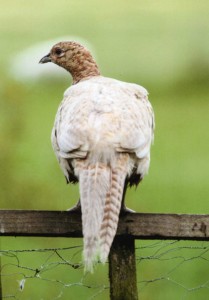 Whilst the garden feeders are being invaded by various birds there are some that have other things on their mind. The early breeding birds in the Highlands generally start around February and include the golden eagle, raven and heron. Perhaps one surprise is the much smaller bird, the dipper, that may well have spent the winter in its territory along river and wide burns. In the garden there is even the start of some display by pheasants, house sparrows and blackbirds. However there are one or two birds, mainly of the pigeon/dove family, that have been found nesting in every month of the year. One of these is now a regular visitor to garden feeders namely the collared dove and as I write there are five under the fruit trees near the house. There are current reports from Glen Strathnairn, just south of Inverness, of a pair of these birds already defying the weather of the winter months.
Whilst the garden feeders are being invaded by various birds there are some that have other things on their mind. The early breeding birds in the Highlands generally start around February and include the golden eagle, raven and heron. Perhaps one surprise is the much smaller bird, the dipper, that may well have spent the winter in its territory along river and wide burns. In the garden there is even the start of some display by pheasants, house sparrows and blackbirds. However there are one or two birds, mainly of the pigeon/dove family, that have been found nesting in every month of the year. One of these is now a regular visitor to garden feeders namely the collared dove and as I write there are five under the fruit trees near the house. There are current reports from Glen Strathnairn, just south of Inverness, of a pair of these birds already defying the weather of the winter months.
A pair of collared doves have been displaying in a garden, collecting nest material and taking to a suitable site in a tall bush. Not that there will be much material to collect as the small flimsy looking nest is made of small twigs and grasses forming a tiny ledge. It does not look as if it could support any eggs albeit they are small, glossy white and there are only two. This may seem foolish to build such a pathetic looking nest and so early but the collared dove has one trick up its sleeve. With such a nest and the time of the year the mortality is very high but its secret lies in the fact that it will just lay and lay clutches of eggs as the year progresses so there is every chance that some young are successful. Three to six broods a year have been recorded which must be the highest score of any other bird in the UK.
We now tend to just accept collared doves and it seems strange to think that it was not very long ago when they did not nest in the UK, let alone in the Highlands. Now it is one of the most widespread of birds and the distribution map shows it all over the British Isles including all the Northern and Western Isles. I have even seen them on that remotest of archipelagos, St Kilda. It comes as a surprise then to realise that the first breeding pair for the Highlands was not until the late 1950s. In June 1957, Alistair Adam found a pair nesting in his farm garden at Covesea, Moray and Nairn. People came from near and far just to see the collared doves. Then there was a spectacular expansion of the bird across Scotland and, unbelievably, by 1965 there were few residential areas that did not support a pair of breeding collared doves. A far cry from now when the bird is such a regular visitor to gardens that it is often overlooked or ignored.
Interestingly the expansion in their range and increase in numbers has slowed down but this is simply because they have occupied all the available sites. However, whilst the bird is considered on the “green list” which means it is not in any danger there are some worrying indications of change. Numbers in some areas have fallen and this is mainly because the main food they like, such as grain in farmers’ fields, has decreased remarkably. This is one of the reasons why it is a so common as a visitor to garden feeding stations. Even there, however, the numbers have fallen in the last few years.
